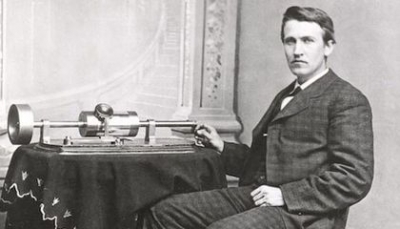
To capture a sound and make it heard again was something unimaginable in those days. When Edison made the first ever machine that could do this, it created a sensation.
It was the phonograph, the first great invention to be developed at Menlo Park. The phonograph first used paraffin paper on a cylinder to record and reproduce sound, but later this was changed to metallic foil. This magical invention brought international fame to Edison.
As we saw earlier, the telephone was then seen as a telegraph machine that uses sound. During the summer of 1877, Edison was trying to make a device that could make markings of the sound it received through the telephone, which could then be delivered as telegraphic messages. He tried this out with a carbon transmitter tipped with a stylus that could make impressions on a strip of paraffined paper. One could hardly see the scratches made by the stylus. But Edison was surprised to note that a vague reproduction of sound was heard when the paper was pulled back under the stylus.
Later that year, Edison had the device made using tin foil instead of wax, and he was able to record the rhyme, ‘Mary had a little lamb’. Later he improved the design to include a lighter needle to trace the grooves and transmit the vibrations to a second diaphragm that recreated a person’s voice. He was granted a patent for this, the following year.
In the years that followed, Edison came up with different improved versions of this device.
Picture Credit : Google




